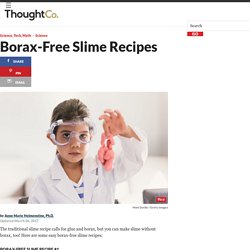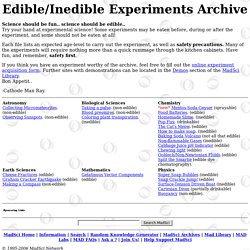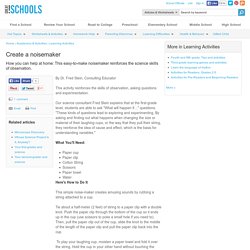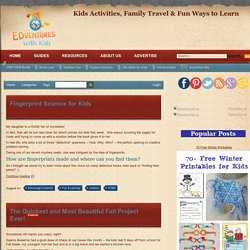

Free Science Activities for Kids. 20 AMAZING SCIENCE EXPERIMENTS TO DO AT HOME! Compilation. EASY SCIENCE EXPERIMENTS TO DO AT HOME. EASY SCIENCE EXPERIMENTS TO DO AT HOME. 10 Ready-to-Go Resources for Teaching Life Cycles. Weather science: How to make a cloud in a jar (2 different methods!) How to Make a Cloud in a Bottle - Science Demonstration. Here's a quick and easy science project you can do: make a cloud inside a bottle.

Clouds form when water vapor forms tiny visible droplets. This results from cooling the vapor. It helps to provide particles around which the water can liquefy. In this project, we'll use smoke to help form a cloud. DragonflyTV . Science Surprises . Liquid, or Solid?! DragonflyTV . Science Surprises . Screaming Balloon! Borax-Free Slime Recipes. The traditional slime recipe calls for glue and borax, but you can make slime without borax, too!

Here are some easy borax-free slime recipes: Borax-Free Slime Recipe #1 You may see this slime called "goo. " This is non-toxic slime that flows when you pour it or set it down but stiffens if you punch it or squeeze it. 1/2 cup liquid starch1 cup white gluefood coloringMix together the liquid starch and glue.Add food coloring if you want colored slime. Borax-Free Slime Recipe #2 1-1/2 cups flour1 cup cornstarch1-1/2 cups waterfood coloringIn a saucepan, mix together the cornstarch, 3/4 cup of water and the food coloring.Heat the mixture over low heat until it is warm.Stir in the flour, a little at a time, until all of it has been added.Stir in the remaining water.
Make Non-Toxic Glue From Milk. Updated November 27, 2014 Use common kitchen materials to make your own glue.

Add vinegar to milk, separate the curds, and add baking soda and water. Glue! Difficulty: Average. How Do You Prove Air Has Volume (Takes Up Space)? Air, and how it behaves and moves, is important to understanding the basic processes that lead to weather.

But because air (and the atmosphere) is invisible, it can be hard to think of it as having properties like mass, volume, and pressure -- or even being there at all! These simple activities and demos will help you prove that air indeed has volume (takes up space). Make a Liquid Layers Density Column. When you see liquids stack on top of each other in layers, it's because they have different densities from each other and don't mix well together.

You can make a density column—also known as a density tower—with many liquid layers using common household liquids. This is an easy, fun and colorful science project that illustrates the concept of density. Density Column Materials You can use some or all of these liquids, depending on how many layers you want and which materials you have handy. These liquids are listed from most-dense to least-dense, so this is the order you pour them into the column: Filling Without Spilling. Sick Science! Science Fair Ideas Video for Kids - Be captivated watching the excellent selected and really easy to understand Science Fair Ideas facts for kids video: This is a great video that shows fun experiments you can do that is about exothermic reactions.

With this video, you will be able to see the “hot ice” experiment, which turns water into ice with just a touch of a finger. You will find a list of the materials needed for this project in the video. The video will show the step by step tutorial on how to make this project and demonstrates different kinds of experiments that show the same principle. Explore, Play, Discover: Websites, Activities, and More. Christmas star › Tricks (ABC Science) The Surfing Scientist › Tricks Celebrate the Yuletide with this classic trick.

Five wooden toothpicks, a straw and some water are all you need to be the Christmas dinner science star. By Ruben Meerman Can't see the video? Download an mp4 [21 MB] version of this video. Kids and Teens: School Time: Science: Experiments. SCIENCE FAIR PROJECTS: Kids' science projects here, THE SCIENCE CLUB. Edible/Inedible Experiments Archive. Science should be fun.. science should be edible..

Try your hand at experimental science! Some experiments may be eaten before, during or after the experiment, and some should not be eaten at all! Each file lists an expected age-level to carry out the experiment, as well as safety precautions. Many of the experiments will require nothing more than a quick rummage through the kitchen cabinets. Have fun, and remember, safety first. If you think you have an experiment worthy of the archive, feel free to fill out the online experiment acquisition form. -Cathode Man Ray. Fun science experiments and project ideas for kids - educational, exciting and safe. Sci. Biome in a Baggie. Science Snacks: Projects and Activities You Can Do! Arvind Gupta. Our core belief is that children learn by doing - by touching, feeling, cutting, sticking -- pulling things apart, putting things together.
We believe that this hands-on science helps them relate to curriculum and get conceptual understanding. We believe this will revolutionize the way children learn. A child lighting up a LED with a Syringe Generator is more likely to light up his village tomorrow. Our approach is inclusive. All the materials used in our activities are very affordable and accessible to every child across the globe, developing or developed countries alike.
Ours is the most cost effective outreach program in the world, with cost of 15 paisa per person (0.2 cents per person). Our Goal We want to design science and math activities to comprehensively cover the whole curriculum. Toys from Trash. Sick Science! The Color-Changing Celery Experiment! Food Science Archives - The Lab. Healthy Kids : Healthy Kids Activities. Why do leaves change color in fall? Balloon in a bottle Experiment: balloon, bottle, en, experiments, method, prediction, science. Primary Projects. Activity: Create a noisemaker - Learning Activities. By Dr.

Fred Stein, Consulting Educator This activity reinforces the skills of observation, asking questions and experimentation. Our science consultant Fred Stein explains that at the first-grade level, students are able to ask "What will happen if…" questions. "These kinds of questions lead to exploring and experimenting. By asking and finding out what happens when changing the size or material of their laughing cups, or the way that they pull their string, they reinforce the idea of cause and effect, which is the basis for understanding variables.
" Science club activities. Science - Edventures with Kids. We are gearing up for some science fun with this week's Discover & Explore linky.

I love introducing hands-on science activities to kids so that they can experiment, think and ponder all those wonderful questions they love to ask to stump their parents ;) There are a number of easy ways to learn with science -- many of them arise from the questions the kids have about things they see happening in the world around them. For fun ideas about how to introduce every day science concepts, try a few of these fun ways to teach kids about science. Other questions are more easily answered with a quick experiment like this one on optial illustions. My kids have always been crazy over the optical illusions they see in books and very intrigued in how it's done. Amazing Optical Illusions Xtreme Illusions (National Geographic Kids) An optical illusion is a visual image that can be perceived differently depending on how you look at it.
Home. Fun Science Experiments for Kids - Cool Projects & Easy Ideas for Children. All About Your Senses: Experiments to Try. Skip Navigation KidsHealth from Nemours. Make a Bouncing Polymer Ball - Experiment with Polymers. Introduction Balls have been toys practically forever, but the bouncing ball is a more recent innovation. Bouncing balls were originally made of natural rubber, though now bouncing balls can be made of plastics and other polymers or even treated leather.
You can use chemistry to make your own bouncing ball. Once you understand the basic technique, you can alter the recipe for the ball to see how the chemical composition affects the bounciness of the ball, as well as other characteristics. The bouncing ball in this activity is made from a polymer. 11 cheap gifts guaranteed to impress science geeks. Science comes up with a lot of awesome stuff, and you don't need a Ph.D, a secret lab, or government funding to get your hands on some of the coolest discoveries. We've got a list of 11 mostly affordable gifts that are guaranteed to blow your mind, whether or not you're a science geek.
Click on any image to see it enlarged. 1. Aerogel Also known as frozen smoke, Aerogel is the world's lowest density solid, clocking in at 96% air. Aerogel isn't just neat, it's useful. Pinto Bean Germination Experiment. Ready, set, grow! How long does it take for a bean to get growing? How does a beanstalk grow in the first place? Science Experiments You Can Do At Home or School. Top 10 Mad Science-Worthy Chemistry Experiments. Experiments. Science for Kids - Fun Experiments, Cool Facts, Online Games, Activities, Projects, Ideas, Technology.
Build Your Own Lungs. Type. Là est la question. Manipulations Verse un peu de lait dans le bol Ensuite, dépose quelques gouttes de colorant alimentaire sur la surface du lait, mais sans mélanger.